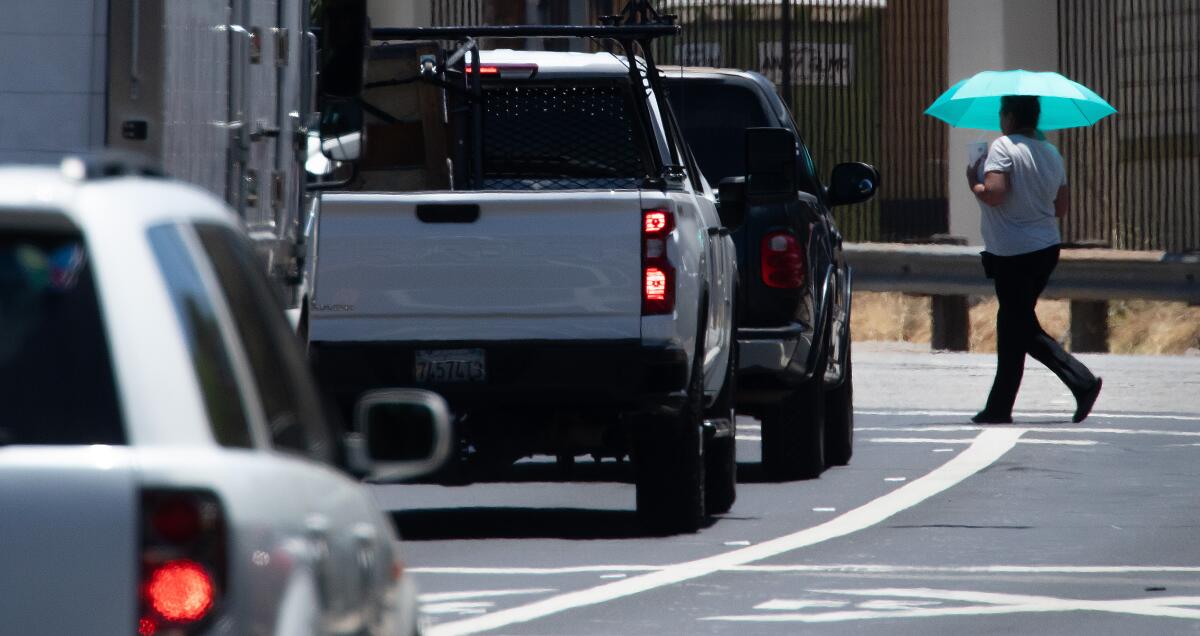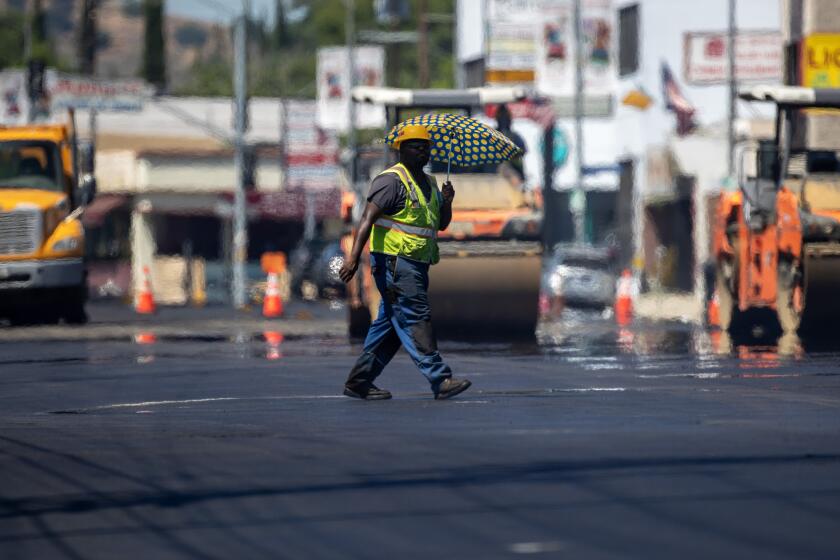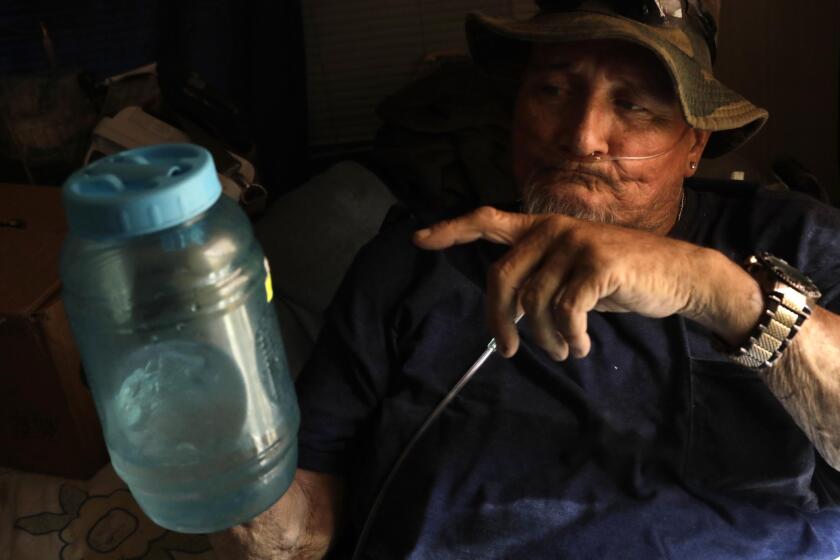L.A. County looks to require rental units to stay cool in summer

- Share via
This winter, renters in frigid Los Angeles apartments have some ammo when they complain to their landlord about busted heating and drafty rooms: Legally speaking, rental units aren’t supposed to dip below a balmy 70 degrees.
Come summer, there are no such protections for the reverse issue: stifling, air-conditioning-less homes. The county has no maximum temperature for rental units, an issue advocates say leaves vulnerable renters sweltering in the hot months as California grapples with the effects of climate change and extreme heat.
Los Angeles County’s supervisors want to change that. On Tuesday, the board voted to direct staff to start drafting an ordinance that would set a maximum temperature for rental units across much of the county. Supervisor Kathryn Barger cast the sole no vote.
“Tenants should have the opportunity to escape extreme heat in their own homes without fear of being evicted or burdened with additional rent fees,” said Supervisor Hilda Solis, who authored the motion along with Supervisor Lindsey Horvath.
With a global average temperature of 58.96 degrees, the year was nearly one-third of a degree warmer than the previous hottest year on record, according to officials.
Unlike many of the motions passed by the county, the resulting ordinance could potentially apply to far more than just the roughly 1 million residents of unincorporated L.A. County.
Because the county’s looking to add the policy to its health code, other jurisdictions in L.A. County would have the chance to easily adopt it. The only exceptions are the cities of Long Beach and Pasadena, which have their own public health departments.
L.A. County will be one of the biggest jurisdictions to take this on — but not the first. In Phoenix, landlords are required to keep units with air conditioning at a maximum of 82 degrees. In Clark County, Nev., units can’t get hotter than 85 degrees. In Palm Springs, units need to have air conditioning and can’t go above 80 degrees.
Horvath said increasingly deadly heat waves presented a clear public health emergency for the county.
“Setting a maximum temperature for rental units will protect our most vulnerable Angelenos, including older adults and families with young children, who deserve safety and comfort in their own home,” she said in a statement.
Horvath’s office said the county doesn’t want to dictate how exactly landlords must keep their units cool. Some will probably need to get air conditioners or heat pumps. But others in more temperate swaths of the county could use energy-efficient upgrades — such as air sealing, cool roofs or even replacing an old window — to keep their units at the desired temperature, officials said.
The county doesn’t yet know what the maximum temperature will be. The county Public Health Department has previously recommended a maximum temperature of 82 degrees for units with an air conditioner and 86 degrees for those without one. But the county supervisors say they’re not interested in a range. Tuesday’s motion asks for an ordinance with a single maximum temperature.
It’s also not clear what kind of teeth the ordinance will have to ensure landlords keep their units cool. In other jurisdictions with maximum temperatures, renters can file a complaint, forcing their landlords to face fines.
As summer heat worsens, voters back mandatory cooling standards for buildings and expanded federal disaster aid, a new Berkeley IGS/Los Angeles Times poll finds.
Landlords and building owners have expressed concern about the possible expenses associated with the motion, with the California Apartment Assn. writing in a recent letter to the board that such upgrades “potentially require significant capital expenditure, building rehabilitation and will have a financial impact on residents.”
“Apartment buildings were built to code at the time and operators find themselves facing changing climate conditions through no fault of their own,” read the letter from Fred Sutton, the group’s senior vice president of local public affairs. “There could be unintended consequences which departments and the Board of Supervisors should be aware of prior to ordinance creation. We respectfully ask that a thorough and holistic study be conducted in concurrence with stakeholder feedback and before an ordinance is directed.”
But Californians largely stand behind the idea, according to a September poll from the UC Berkeley Institute of Governmental Studies co-sponsored by The Times. Sixty-seven percent of voters said they supported the concept of the state establishing cooling standards for residential properties.
And though the move could be expensive for building owners, environmental groups say it could save many lives.
“It’s an important, meaningful step forward in developing this innovative protection for at-risk people,” said Louis Blumberg, senior climate policy advisor with Climate Resolve.
Last year was the planet’s hottest year on record, and temperatures are only expected to increase in the years to come. In July, Phoenix experienced a record 31 consecutive days of temperatures of 110 degrees or higher, and Death Valley in California soared to 128 degrees — a near world record.
The motion cited a 2021 Times investigation that found extreme-heat deaths are chronically undercounted in the state, and that the number of heat-related deaths between 2010 and 2019 could be as high as 3,900.
That number could rise to 4,300 people annually by 2025, and 11,300 by 2050 as heat waves worsen, according to projections from the California Department of Public Health.
“As human-caused climate change continues to alter our environment, Los Angeles County heat waves are worsening,” the motion says. It notes that California’s heat waves have become more frequent, longer and more intense in the last 70 years. The region is now 2 degrees warmer than in the 1950s, with an additional 4 to 5 degrees of warming expected in the coming decades, it says.
Read all of our coverage about how California is neglecting the climate threat posed by extreme heat.
But extreme heat is already a killer, contributing to more deaths than any other natural disaster, according to the National Oceanic and Atmospheric Administration.
Such conditions are often felt most acutely in low-income communities and communities of color, which see disproportionately low levels of tree canopy and suffer from the urban heat island effect, by which asphalt and pavement absorb heat and drive local temperatures up by several degrees.
Blumberg noted that extreme heat also tends to affect the most vulnerable, including children, the elderly, and people with underlying medical conditions, who can have a harder time regulating their body temperature.
“Heat is a serious threat, especially to a whole suite of marginalized communities,” he said. “The problem will only get worse as the planet continues to warm.”
And while experts at Climate Resolve are supportive of the motion, they also said there are ways it could be improved. For one, more clarity is needed around whether a range of temperatures would be acceptable, or whether there is a single limit, such as 82 degrees, Blumberg said.
Additionally, providing cooling units is only one of several steps needed to ensure efficiency and results, he said. Older buildings in particular will need to be insulated and weatherized to prevent cool air from escaping. Planting trees is also essential to providing more shade and cooling across the region.
“Society needs a comprehensive integrated approach to addressing extreme heat,” Blumberg said. “There’s many things that can be done and should be done, and they work in concert.”
The campaign — part of Newsom’s $404-million Extreme Heat Action plan — will partner with 121 community-based organizations to conduct outreach in every county.
Among other items, the motion calls for a phased approach that would see recently constructed dwellings immediately subject to the maximum indoor heat temperature threshold, along with buildings undergoing substantial remodeling. Existing buildings would be granted extended time to comply with the threshold, with additional considerations based on the age of the building, the number of units and the landlord’s financial ability to comply, the motion says.
Additionally, the motion calls for anti-displacement provisions to prevent landlords from passing the cost of complying with the ordinance to tenants through additional fees, rent or other charges where possible, as well as updated tenant protections to ensure the practices are not considered cause for eviction.
County officials are being tasked with identifying potential funding streams and access to federal and state resources to help implement the program, including providing assistance to small landlords and low-income tenants “who would be unduly burdened by a retrofit requirement,” the motion says.
California is considering setting residential cooling guidelines at the state level, and some opponents urged the board to wait for that decision.
“This motion is extremely premature,” Jesus Rojas, government affairs coordinator with the Apartment Assn. of Greater Los Angeles, told the board Tuesday. He underscored the high cost of adding cooling to residential units, and said the board should let officials at the state level conclude their research and develop any recommendations before proceeding.
“At a time when both mom-and-pop owners and renters are still struggling financially to recover from the impacts of COVID-19, this motion seems particularly callous and tone-deaf to the needs of L.A. County residents,” he said.
The state is also considering setting cooling standards for indoor workers. Previous reports have found that in places such as the Inland Empire, temperatures in warehouses can climb to 90 degrees or higher. The California Division of Occupational Safety and Health is expected to vote on that matter as soon as March.
“Part of the benefit of the county ordinance is it pushes the state and supports that process and creates some momentum at the state level for action,” Blumberg said.
Such decisions can’t come soon enough, he said. The “heat season” in California will start in about 90 days.
“We could be saving lives,” Blumberg said. “These are preventable deaths.”
More to Read
Sign up for Essential California
The most important California stories and recommendations in your inbox every morning.
You may occasionally receive promotional content from the Los Angeles Times.
















